
Stilleben, 1613, Flores Van Dyck
Ethos of Making

Stilleben, 1613, Flores Van Dyck

I love the string of well-worn Windsors at our local laundromat
My friend Mike High was well known in our art school days for coining mock mottos and platitudes that were equally absurd and profound, a grey zone that defines the genre. One of my favorites was, “when I launder, my mind wanders; when I wander, my mind laundersâ€. It’s been over 25 years since I last pondered this, and almost as long since I’ve spent any time in a laundromat, which is where I found myself by hazard the other night when our washing machine suddenly broke down. ????? ??? ??????
I’ve had a rare confluence of circumstances over the past week that left me ‘stuck’ in situations, stripped of all options but to simply wait. It’s got me thinking about how much I miss things like riding trains, going to the laundromat, or being snowed in, and what a lost art waiting has become in contemporary life. When I managed to get my truck stuck in the mud on a remote site visit the other day, with just enough charge in my phone to call a friend to tow me out with his tractor, my only option was to sit tight for the afternoon, enjoy the sunshine and take a delicious nap in an apple orchard.
I didn’t realize the extent to which I keep occupied during the course of the day, having successfully eliminated unnecessary pauses and delays from my routine. I had forgotten the feeling of deep comfort and centered-ness and that can accompany unanticipated bouts of boredom. ????? ???? ????? It seems that communications and information technologies have relieved us of many of the anxiety-causing situations that require waiting, but they’ve simultaneously distanced us from the delights of uninterrupted daydreaming. I look forward to retooling my days to increase the odds of idle reverie, and thank fate for having intervened. ???? ?????

some elegant Windsors at a laboratory waiting room in Santa Rosa
//
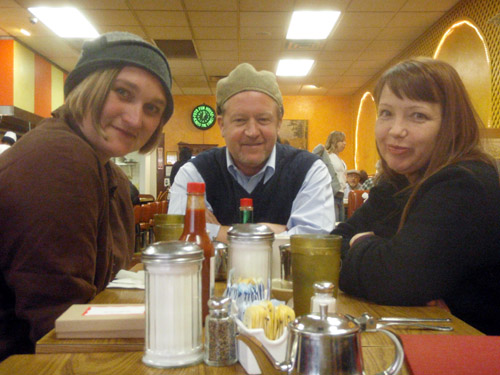
Ene and I met with Victoria Heifner, on right, founder of Milkfed Press
It’s coming up on three years since I started keeping this weblog and I’ve been seriously considering compiling the best of my entries into a book. The narrative has taken many twists and turns, but some consistent patterns have emerged that I think will be most clearly communicated in traditional book form. In keeping with the Deepcraft ethos I plan to collaborate with Milkfed Press to design and produce a limited edition of hand bound, archival quality books, perhaps leading to an annually published series. It’s kind of thrilling to think of gathering material I’ve produced entirely by digital means that lives only in ‘cyberspace’, and making it into a tangible object.
We kicked off the process by meeting over lunch at Ole’s Waffle Shop with our new friend Victoria Heifner, founder of Alameda-based Milkfed Press, specializing in traditional bookbinding and letterpress printing. We got along even better than I had anticipated and the conversation flowed effortlessly, leading to a strategy for designing and producing the book. The combination of Ole’s excellent coffee, homespun diner fare and energetic lunch crowd made for a productive atmosphere and we agreed to always meet there as the project takes shape. I look forward to our next luncheon meeting and plan to bring source materials to help guide the book’s look and feel. Meanwhile, I’d love to hear from anyone with ideas or suggestions, or perhaps a favorite post or two you care to share.
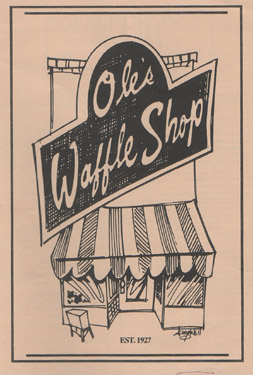
menu cover at Ole’s Waffle Shop, Alameda, CA
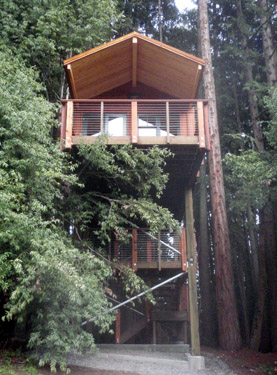
West-facing elevation of House of Tree
I’ve made just two visits to my recently completed House of Tree project and it already feels as though it’s always been there, or at least was always meant to be there. Climbing the 30 steps to the cabin, you wind around the inside of the tower, first facing South, then West, then North, entering onto the back porch after a final ascent to the East. The number of stairs of each climb is roughly in proportion to the scale of the landings they lead to, both increase in number and size, respectively, as you go up. ??? ???? ????? It’s as though if you kept climbing you could reach the vast open sky, kind of how I always pictured happening in Jack and the Beanstalk. betfinal ???? Indeed, entering the structure after winding up the tower has a magical effect; the height off the ground adds to the feeling and it’s easy to drop the cares of the world below once inside.
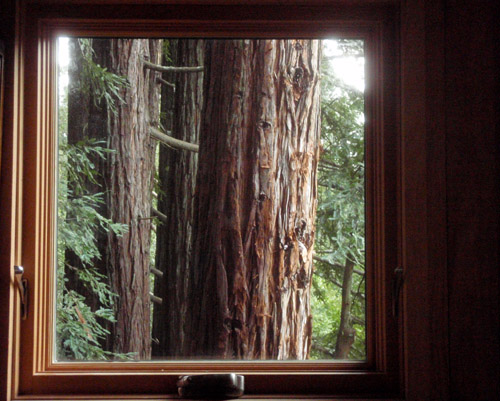
View to the South from the structure’s solitary ‘awning’ window
What makes treehouses of all kinds so universally lovable is that they are all essentially hermitages, places where we go to get away, or to reconnect in some way, usually beginning simply with the dream of being in a tree or of feeling protected in the forest. I designed House of Tree in collaboration with my client, who wanted a secret place to escape to. Its windows frame views of the redwood forest on three sides, with the Western elevation opening out to an apple orchard in a clearing to catch the afternoon sun. Though the cabin is just over 200 square feet, it’s easy to imagine spending a few days with spare provisions, without ever wanting or needing to touch ground.
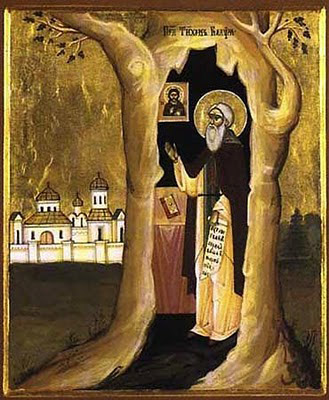
Saint Tikhon of Kaluga
One of the more legendary tree-dwellers is Saint Tikhon of Kaluga, a 15th century Russian monk who lived in a hollow oak tree on the banks of the River Vepreika. A famous monastery and cathedral were eventually built on or near the site of his original hermitage, and a Feast Day is celebrated in his honor on June 16, the date of his death in 1492. I would love to see this date marked as a treehouse holiday in celebration of arboreal living. ???? ?????? ??? ????
//
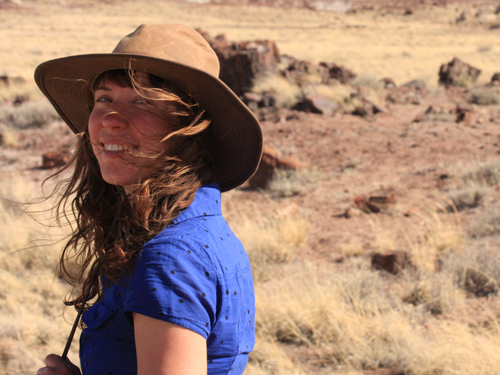
Yvonne Mouser
My interview with San Francisco-based artist/designer/furniture maker Yvonne Mouser is the latest in an ongoing series of interviews and studio visits with other makers/artisans/crafters. You may read more of these by clicking here. If you would like to introduce yourself and your work to a growing Deep Craft network, please drop me a line at scott@deepcraft.org. Meanwhile, allow me to introduce you to my good friend Yvonne:
DC: Describe briefly what you do as a maker/artisan.
Yvonne: I focus on creating simple everyday objects that tell a story through their function, and sculptural works that capture moments of change.  I work independently, as a freelancer, and as a collaborator on projects that range from one–off commissions, small-scale production, finish carpentry and food + design events.
yvonnemouser.com newfactorysf.com thoughtforfood
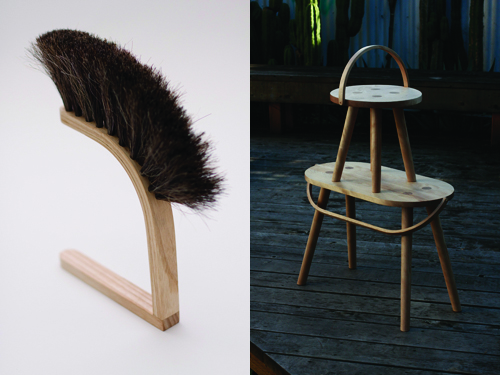 Brush and Stools Continue reading “Interview with Yvonne Mouser”
Brush and Stools Continue reading “Interview with Yvonne Mouser”
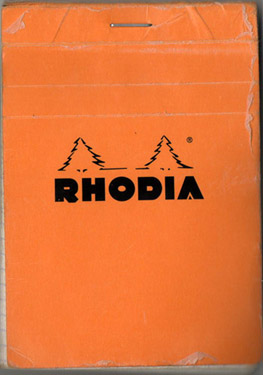
I’m loyal to the Rhodia #12, 5 x 5, 80 g/m2 – 21.3 lb vellum
I’m far from a Luddite. I have a laptop, two websites and a blog, a Facebook profile, do the majority of my reading on a Kindle, use digital cameras and rely on my mobile phone almost exclusively for communication. Without these technologies I would be hard pressed to manage the range of work I do, especially from our remote rural studio. ??? ???? 2024 While I depend upon a host of internet-based, wireless and digital media to increase efficiency and decrease redundancy and waste, I’m not particularly enamored of any of them aesthetically, and devote as little time as possible ‘interfacing’. betfinal
As a maker, the majority of the work I do outside of the studio consists of writing and drawing by hand in a notebook. Next to the pencil, the notebook is by far my favorite tool, the bridge between ideas and their kinesthetic manifestation. To me, giving shape to words and objects by hand, on paper, is a way of embodying ideas in their germinative phase, connecting the senses to the brain by way of the hand. In the hierarchy of skills required to design and make anything, a good notebook ranks high as an indispensable adjunct to craft.
Over the years, I’ve transitioned from Moleskin to Bienfang, experimented with index cards and post-its, but have been loyal to the Bloc Rhodia Number 12 for at least the past six or seven years. The books hold up to daily stowage in my back pocket, where they fit snugly without causing undo concern for the spine. The paper is smooth vellum, and individual sheets are securely bound but perforated for easy tear-out, with a light graph at just the right scale. The paper takes well to pencil, with minimal smudging, and inks do not bleed through. Better still, the notebooks can get completely soaked and will dry out with little effect. Best of all, the bright orange cover always cheers my day. ???? ???????? ?????????
//

I know how long it takes the chain to rust, the paint to peel, the grain to crust.